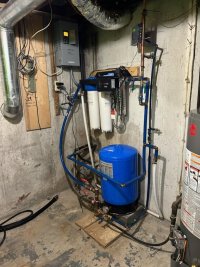we bought a property that has a bungalow and a cottage supplied by one 80 ft deep well.
water supply was never an issue and the water was always clear.
It was recommended that we update the system since we were renovating the Barn into additional living space. ( another home)
this would give us better pressure to reach the second floor of the barn.
So we went from a 1/2 horse power submersible pump to a 1 horse variable speed pump. Dug a new well 2 ft away from the original well ( why not since everything was being upgraded) new pressure tank, and even replaced the lines to a green stripe one inch to handle the 70 psi. This was all in November 2021.
We decided to ad a filter system and UV light.
6 weeks in, and our pressure was none existent. new filter was covered in mud so we quickly replaced the filter and sediment filter.
we are having to replace the filters every 2 -3 weeks. The 3 rd house isn't even lived in yet.
how do we correct this issue?
water supply was never an issue and the water was always clear.
It was recommended that we update the system since we were renovating the Barn into additional living space. ( another home)
this would give us better pressure to reach the second floor of the barn.
So we went from a 1/2 horse power submersible pump to a 1 horse variable speed pump. Dug a new well 2 ft away from the original well ( why not since everything was being upgraded) new pressure tank, and even replaced the lines to a green stripe one inch to handle the 70 psi. This was all in November 2021.
We decided to ad a filter system and UV light.
6 weeks in, and our pressure was none existent. new filter was covered in mud so we quickly replaced the filter and sediment filter.
we are having to replace the filters every 2 -3 weeks. The 3 rd house isn't even lived in yet.
how do we correct this issue?

